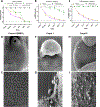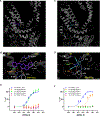Target-based discovery of a broad-spectrum flukicide
- PMID: 38714890
- PMCID: PMC12169134
- DOI: 10.1038/s41594-024-01298-3
Target-based discovery of a broad-spectrum flukicide
Abstract
Diseases caused by parasitic flatworms impart a considerable healthcare burden worldwide. Many of these diseases-for example, the parasitic blood fluke infection schistosomiasis-are treated with the drug praziquantel (PZQ). However, PZQ is ineffective against disease caused by liver flukes from the genus Fasciola because of a single amino acid change within the target of PZQ, a transient receptor potential ion channel in the melastatin family (TRPMPZQ), in Fasciola species. Here, we identify benzamidoquinazolinone analogs that are active against Fasciola TRPMPZQ. Structure-activity studies define an optimized ligand (BZQ) that caused protracted paralysis and tegumental damage to these liver flukes. BZQ also retained activity against Schistosoma mansoni comparable to PZQ and was active against TRPMPZQ orthologs in all profiled species of parasitic fluke. This broad-spectrum activity manifests as BZQ adopts a pose within the binding pocket of TRPMPZQ that is dependent on a ubiquitously conserved residue. BZQ therefore acts as a universal activator of trematode TRPMPZQ and a first-in-class, broad-spectrum flukicide.
© 2024. The Author(s), under exclusive licence to Springer Nature America, Inc.
Conflict of interest statement
Figures









Update of
-
Target-based discovery of a broad spectrum flukicide.bioRxiv [Preprint]. 2023 Sep 22:2023.09.22.559026. doi: 10.1101/2023.09.22.559026. bioRxiv. 2023. Update in: Nat Struct Mol Biol. 2024 Sep;31(9):1386-1393. doi: 10.1038/s41594-024-01298-3. PMID: 37790347 Free PMC article. Updated. Preprint.
References
-
- Andrews P. et al. (1983) Praziquantel. Med Res Rev 3 (2), 147–200. - PubMed
-
- Waechtler A. et al. (2023) Praziquantel - 50 years of research. ChemMedChem, e202300154. - PubMed
-
- Spangenberg T. (2021) Alternatives to Praziquantel for the Prevention and Control of Schistosomiasis. ACS Infect Dis 7 (5), 939–942. - PubMed
-
- Farid Z. et al. (1989) Praziquantel and Fasciola hepatica infection. Trans R Soc Trop Med Hyg 83 (6), 813. - PubMed
-
- Arafa WM et al. (2015) Comparing an in vivo egg reduction test and in vitro egg hatching assay for different anthelmintics against Fasciola species, in cattle. Vet Parasitol 214 (1–2), 152–8. - PubMed
MeSH terms
Substances
Grants and funding
LinkOut - more resources
Full Text Sources

